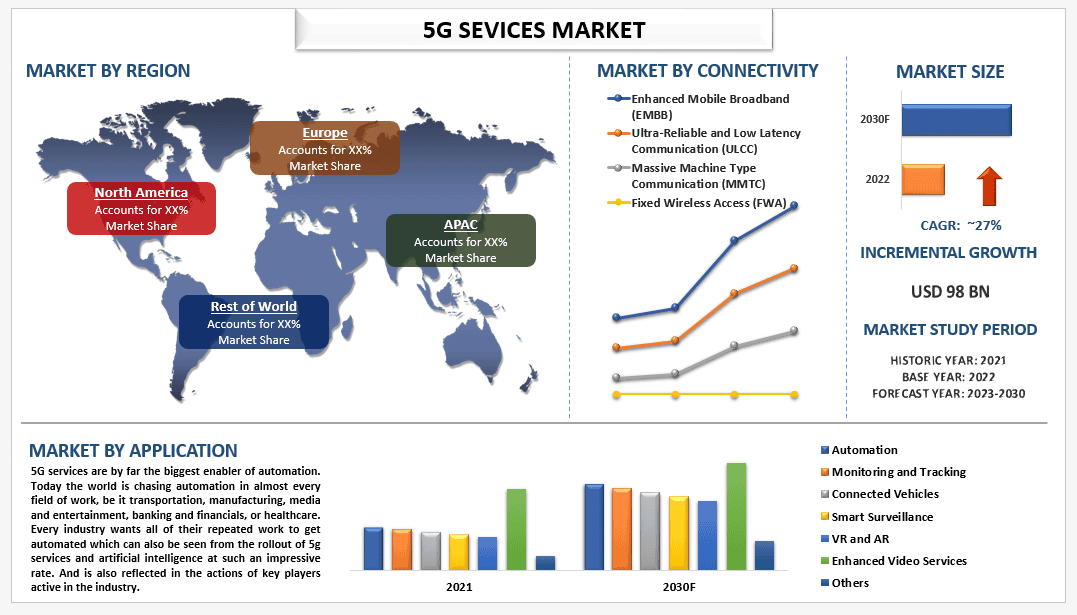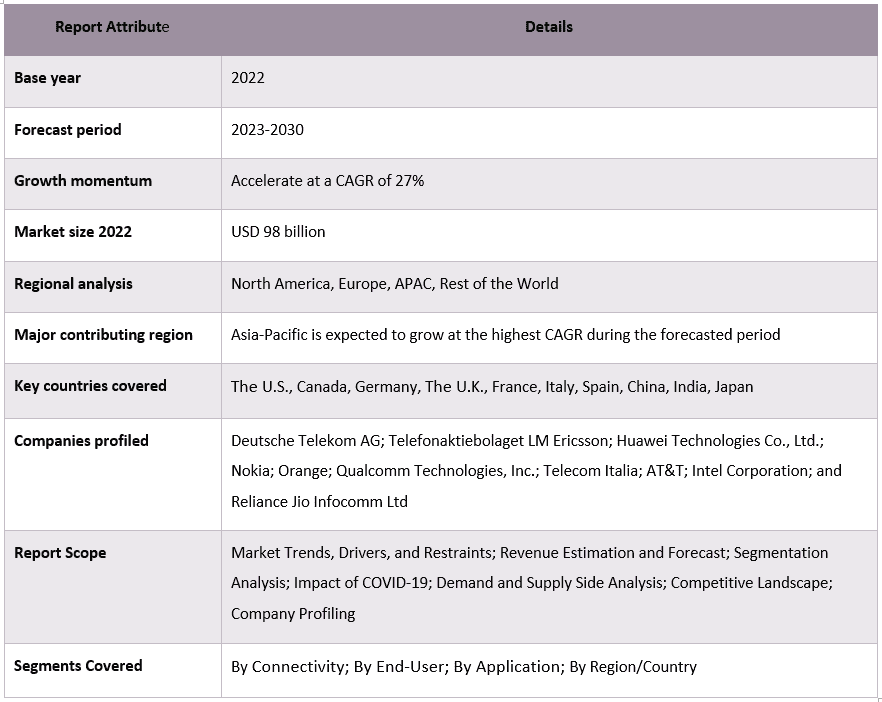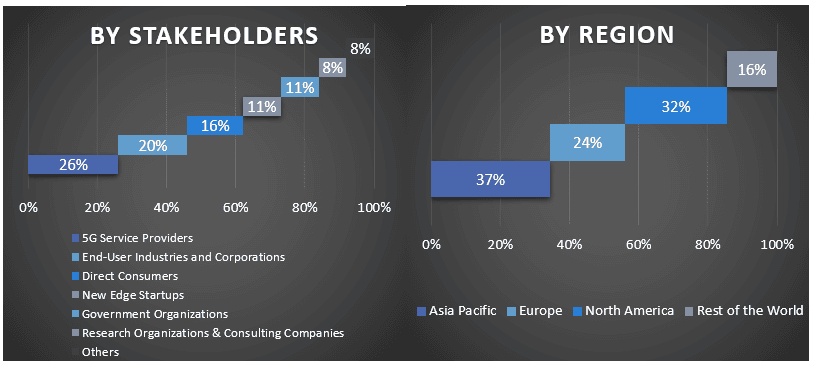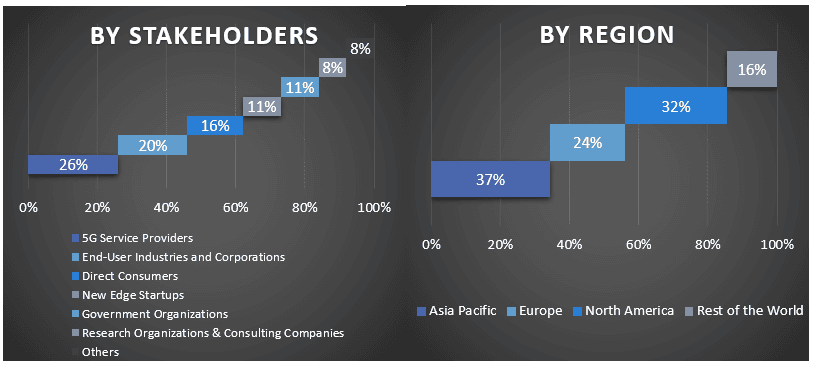Emphasis on Connectivity (Enhanced Mobile Broadband (EMBB), Ultra-Reliable and Low Latency Communication (URLLC), Massive Machine Type Communication (MMTC), Fixed Wireless Access (FWA)), End-User (Manufacturing, Energy & Utilities, Media and Entertainment, IT and Telecommunication, Transportation and Logistics, Healthcare, and Others); Application (Automation, Monitoring and Tracking, Connected Vehicles, Smart Surveillance, VR and AR, Enhanced Video Services, and Others); and Region/Country

The 5G Services Market was valued at 98 billion in the year 2022 and is expected to grow at a steady rate of around 27% during the forecast period (2023-2030), owing to the growing adoption of high-speed internet consumption, rapid digitalization, and rising automation and IoT integration. 5G (fifth generation) wireless network technology is the latest advancement in mobile communication systems. It offers faster data speeds, lower latency, and greater connectivity than its predecessors. With 5G, users can expect more reliable and seamless connections for various applications such as online gaming, virtual reality, and augmented reality. Additionally, 5G enables new use cases like smart cities, autonomous vehicles, and IoT devices. Furthermore, 5G networks offer significantly higher speed and capacity compared to previous generations. This means that users can enjoy faster downloads, smoother streaming, and reduced lag time during online interactions. For instance, in August 2023, Abertay University released the first scenes from their groundbreaking Virtual Production project, which enables actors to collaborate in two distinct locations 280 miles apart using a 5G internet connection in real time. This innovative technique promises to revolutionize the film-making industry. Additionally, 5G supports the growing number of connected devices, making it an ideal choice for IoT applications. Its low power consumption and long battery life enable devices to operate for extended periods, even when they are not plugged into a power source. As a result, 5G opens new possibilities for smart homes, industrial automation, and other IoT initiatives. For instance, as per the survey Industrial IoT (IIoT), which enables industrial automation is one of the major reasons for the fast rollout of 5G services. Harnessing the strength of the integration of 5G and IoT allows the development of smart factories, where machines, equipment, and sensors can collaborate, communicate, and optimize manufacturing procedures in real time, thereby decreasing downtime and improving overall operational efficiency. Enabling the creation of interconnected and ultra-receptive structures that provide predictive maintenance, remote tracking, and autonomous control of machinery.
Some of the major players operating in the market include Deutsche Telekom AG; Telefonaktiebolaget LM Ericsson; Huawei Technologies Co., Ltd.; Nokia; Orange; Qualcomm Technologies, Inc.; Telecom Italia; AT&T; Intel Corporation; and Reliance Jio Infocomm Ltd. Several M&As along with partnerships have been undertaken by these players to facilitate customers with hi-tech and innovative products/technologies.
Insights Presented in the Report
“Amongst Connectivity, the EMBB segment held the significant share of the market in 2022.”
Based on connectivity, the market is segmented into enhanced mobile broadband (EMBB), ultra-reliable and low latency communication (URLLC), massive machine type communication (MMTC), and fixed wireless access (FWA). The EMBB segment holds a significant share of the market. The primary factor that is responsible for this dominance are growing demand for high-speed mobile broadband. With the increasing penetration of smartphones and other mobile devices, there is a growing demand for high-speed mobile broadband services. eMBB is well-suited to meet this demand, offering faster data rates and lower latency than traditional mobile broadband services. Furthermore, as 5G networks expand, eMBB is likely to become a major component of these networks, providing high-speed mobile broadband services to a wider range of users. Moreover, eMBB is already being used in emerging use cases such as smart cities, intelligent transportation systems, and remote healthcare. This growing demand for EMBB can also be seen from the new technological developments, product launches related to this vertical, and key player investments that are undertaken in this space.
“Amongst applications, the automation segment is anticipated to grow at a significant CAGR during the forecast period (2023-2030).”
Based on application, the market is segmented into automation, monitoring and tracking, connected vehicles, smart surveillance, VR and AR, enhanced video services, and others. 5G services are by far the biggest enabler of automation. Today the world is chasing automation in almost every field of work, be it transportation, manufacturing, media and entertainment, banking and financials, or healthcare. Every industry wants all their repeated work to get automated which can also be seen from the rollout of 5g services and artificial intelligence at such an impressive rate. And is also reflected in the actions of key players active in the industry. For instance, in February 2023, At Mobile World Congress Barcelona 2023, Schneider Electric, Capgemini, and Qualcomm Technologies, Inc. announced their collaboration on a pioneering 5G-enabled automated hoisting solution. The three companies combined their efforts to design and install the solution at Schneider Electric’s hoisting lab in Grenoble, France. By replacing wired connections with a wireless solution and unifying existing wireless connections from Schneider Electric’s industrial automation system, the 5G Private Network demonstrates how it simplifies and optimizes digital technology deployment at scale, from steel plants to ports.
5G Services Market Report Coverage

“Asia-Pacific to lead the growth in the 5G services segment during the forecasted period (2022-2030).”
Asia-Pacific is emerging as the fastest-growing 5g services market in CAGR terms. The region has witnessed a considerable rise in smartphone penetration and with the huge population and rapid urbanization, Asia Pacific has become a giant in terms of data consumption and data generation. In addition to this, the price of the internet is the lowest in the region as compared to the developed world’s further boosting the demand and adoption of high-speed internet. Moreover, the region is witnessing an exponentially growing digital economy, expanding itself in every functioning industry of the region. Additionally, the region is both an export as well as a consumption-led economy, hence industrialization is bound to grow, raising the need for automation for which 5G services are the biggest enabler. The factors stated above along with governments’ proactiveness in the technology space are going to contribute to the long-term growth of the industry in the region.
Reasons to buy this report:
Customization Options:
The global 5G services market can further be customized as per the requirement or any other market segment. Besides this, UMI understands that you may have your own business needs, hence feel free to contact us to get a report that completely suits your requirements.
1. Market Introduction
2. Research Methodology Or Assumption
3. Market Synopsis
4. Executive Summary
5. Impact Of Covid-19 On The 5g Services Market
6. G Services Market Revenue (usd Bn), 2020-2030f
7. Market Insights By Connectivity
8. Market Insights By End-user
9. Market Insights By Application
10. Market Insights By Region
11. G Services Market Dynamics
12. G Services Market Opportunities
13. G Services Market Trends
14. Demand And Supply-side Analysis
15. Value Chain Analysis
16. Competitive Scenario
17. Company Profiled
18. Disclaimer
Research Methodology for the 5G Services Market Analysis (2023-2030)
Analyzing the historical market, estimating the current market, and forecasting the future market of the global 5G services market were the three major steps undertaken to create and analyze the adoption of 5G services in major regions globally. Exhaustive secondary research was conducted to collect the historical market numbers and estimate the current market size. Secondly, to validate these insights, numerous findings and assumptions were taken into consideration. Moreover, exhaustive primary interviews were also conducted, with industry experts across the value chain of the global 5G services market. Post assumption and validation of market numbers through primary interviews, we employed a top-down/bottom-up approach to forecasting the complete market size. Thereafter, market breakdown and data triangulation methods were adopted to estimate and analyze the market size of segments and sub-segments of the industry pertains to. Detailed methodology is explained below:
Analysis of Historical Market Size
Step 1: In-Depth Study of Secondary Sources:
A detailed secondary study was conducted to obtain the historical market size of the 5G services market through company internal sources such as annual reports & financial statements, performance presentations, press releases, etc., and external sources including journals, news & articles, government publications, competitor publications, sector reports, third-party database, and other credible publications.
Step 2: Market Segmentation:
After obtaining the historical market size of the 5G services market, we conducted a detailed secondary analysis to gather historical market insights and share for different segments & sub-segments for major regions. Major segments are included in the report as connectivity, end-user, and application. Further country-level analyses were conducted to evaluate the overall adoption of testing models in that region.
Step 3: Factor Analysis:
After acquiring the historical market size of different segments and sub-segments, we conducted a detailed factor analysis to estimate the current market size of the 5G Services market. Further, we conducted factor analysis using dependent and independent variables such as connectivity, end-user, and application of the 5G services market. A thorough analysis was conducted for demand and supply-side scenarios considering top partnerships, mergers and acquisitions, business expansion, and product launches in the 5G services market sector across the globe.
Current Market Size Estimate & Forecast
Current Market Sizing: Based on actionable insights from the above 3 steps, we arrived at the current market size, key players in the global 5G Services market, and market shares of the segments. All the required percentage shares split, and market breakdowns were determined using the above-mentioned secondary approach and were verified through primary interviews.
Estimation & Forecasting: For market estimation and forecast, weights were assigned to different factors including drivers & trends, restraints, and opportunities available for the stakeholders. After analyzing these factors, relevant forecasting techniques i.e., the top-down/bottom-up approach were applied to arrive at the market forecast for 2030 for different segments and sub-segments across the major markets globally. The research methodology adopted to estimate the market size encompasses:
Market Size and Share Validation
Primary Research: In-depth interviews were conducted with the Key Opinion Leaders (KOLs) including Top Level Executives (CXO/VPs, Sales Head, Marketing Head, Operational Head, Regional Head, Country Head, etc.) across major regions. Primary research findings were then summarized, and statistical analysis was performed to prove the stated hypothesis. Inputs from primary research were consolidated with secondary findings, hence turning information into actionable insights.
Split of Primary Participants in Different Regions

Market Engineering
The data triangulation technique was employed to complete the overall market estimation and to arrive at precise statistical numbers for each segment and sub-segment of the global 5G services market. data was split into several segments & sub-segments post studying various parameters and trends in the areas of the voltage, application, and end-user in the global 5G services market.
The main objective of the Global 5G Services Market Study
The current & future market trends of the global 5G services market were pinpointed in the study. Investors can gain strategic insights to base their discretion for investments on the qualitative and quantitative analysis performed in the study. Current and future market trends determined the overall attractiveness of the market at a regional level, providing a platform for the industrial participant to exploit the untapped market to benefit from a first-mover advantage. Other quantitative goals of the studies include:

Customers who bought this item also bought